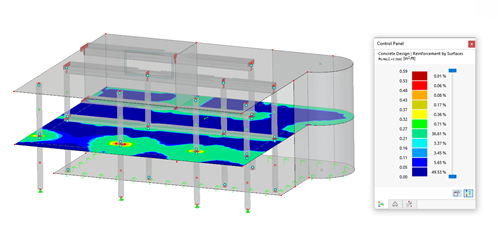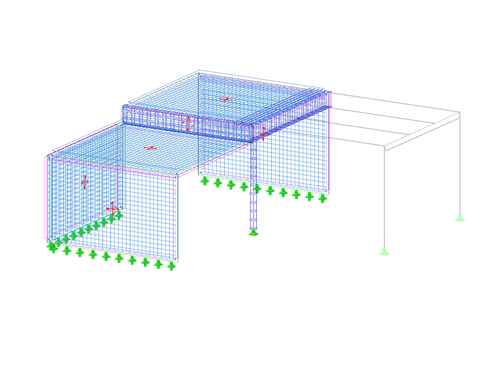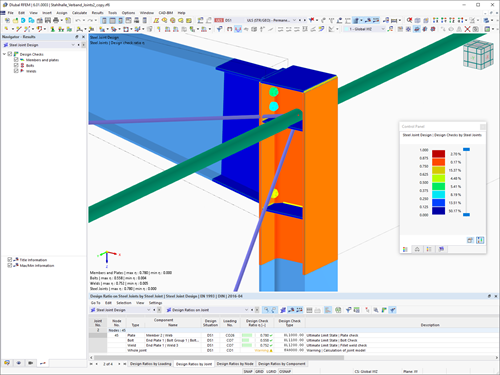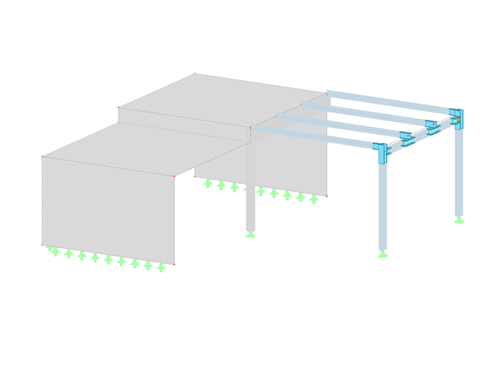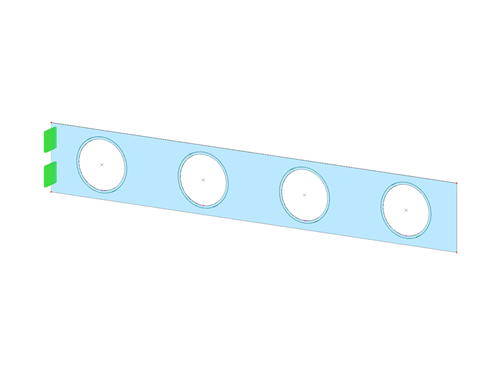The Concrete Design add-on allows you to design reinforced concrete members and surfaces according to various design standards. It is possible to perform the ultimate limit state and serviceability limit state design checks. The input and result evaluation are completely integrated in the user interface of the structural FEA software RFEM and the frame & truss analysis software RSTAB.
This manual describes the Concrete Design add-on for RFEM 6 and RSTAB 9. In RSTAB, you can only design members and member sets, not surfaces.
In this tutorial, we would like to inform you about the essential features of the RFEM program. In the first part, a model was defined and a structural analysis was carried out. The second part deals with the concrete design of the slabs, walls, beams, and the column according to EN 1992‑1‑1 with the CEN settings.
In this tutorial, we would like to inform you about the essential features of the RFEM program. In the first part, a model was defined and a structural analysis was carried out. Now, the second part deals with the concrete design of slabs, walls, beams, and the column. ACI 318-19 is used as a standard.
Dynamic analyses in RFEM 6 and RSTAB 9 can be performed in several add-ons.
- The Modal Analysis add-on is the basic add-on, performing natural vibration analyses for member, surface, and solid models. It is a prerequisite for all other dynamic add-ons.
- The Response Spectrum Analysis add-on allows you to perform a seismic analysis using the multi-modal response spectrum analysis.
- The Time History Analysis add-on allows for a dynamic structural analysis of external excitations that can be defined as a function of time.
- The Pushover Analysis add-on allows you to determine the maximum nonlinear response of a structure to seismic loads.
- The Harmonic Response Analysis add-on is still under development.
This manual describes the dynamic analysis add-ons for RFEM 6 and RSTAB 9.
The Aluminum Design add-on allows you to design aluminum members according to various design standards. It is possible to perform cross-section resistance checks, stability analyses, and serviceability limit state design checks. The input and result evaluation are completely integrated in the user interface of the structural FEA software RFEM and the frame & truss analysis software RSTAB.
This manual describes the Aluminum Design add-on for the RFEM 6 and RSTAB 9 programs.
The "Steel Joints" add-on allows for the analysis of connections on the basis of an FE model. The design checks are carried out for various connection types for rolled and welded cross-sections. The input and result evaluation are completely integrated in the user interface of the structural FEA software RFEM.
This manual describes the Steel Joints add-on for RFEM 6.
In this tutorial, we would like to inform you about the essential features of the RFEM program. In the first part, a model was defined and a structural analysis carried out. Then the concrete and steel designs were performed in the following parts. This part now deals with the design of the steel connections according to EN 1993-1-8 with the CEN settings.
In this tutorial, we would like to inform you about the essential features of the RFEM program. In the first part, a model was defined and a structural analysis carried out. Then the concrete and steel designs were performed in the following parts. This part now deals with the design of the steel connections according to AISC 360-22.
The Torsional Warping (7 DOF) add-on allows you to consider the cross-section warping as an additional degree of freedom for a global calculation of members in RFEM and RSTAB. The input and result evaluation are completely integrated in the user interface of the structural FEA software RFEM and the frame & truss analysis software RSTAB.
This manual describes the Torsional Warping (7 DOF) add-on for the programs RFEM 6 and RSTAB 9.
The Optimization & Costs/CO2 Emission Estimation add-on consists of two parts: On the one hand, you can use it to determine an optimal parameter layout for parameterized models, based on the user-defined optimization criteria. For this purpose, the artificial intelligence technology (AI) of particle swarm optimization (PSO) is used. On the other hand, you have the option to estimate the costs and CO2 emissions of a model by specifying the unit costs and emissions for the materials used in the model.
This manual describes the features of the add-on for the programs RFEM 6 and RSTAB 9. The explanations refer to RFEM, but also apply to RSTAB.
